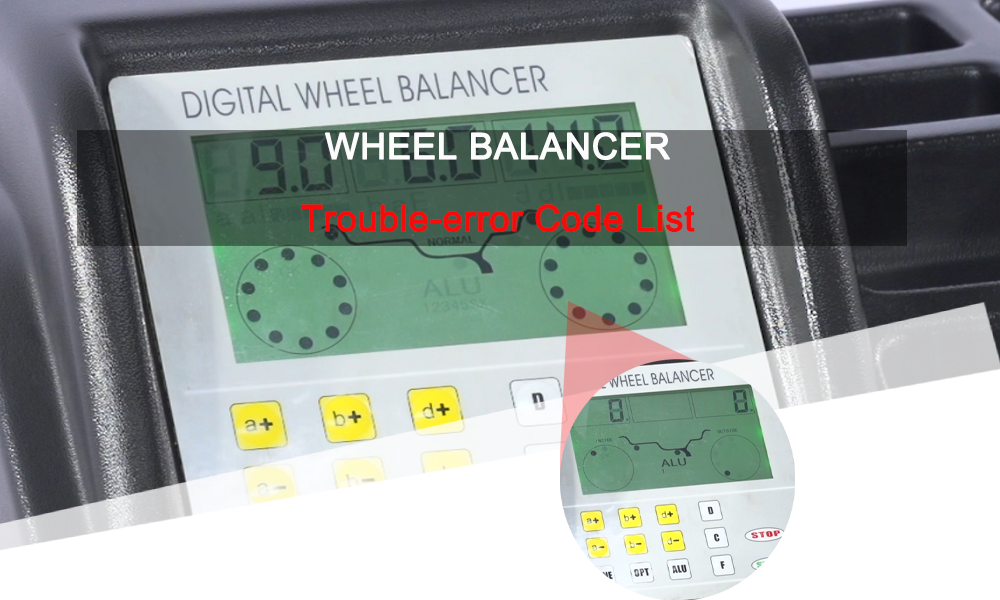A wheel balancer is a critical tool for auto repair shops that ensures the proper balance of a tire and wheel assembly. While wheel balancers are built to last, they can still experience problems, especially if they are not maintained or calibrated properly. The most common problems with wheel balancers are trouble-error codes, which can disrupt the balancing process and lead to inaccurate results. In this article, we will provide a guide to help you understand these codes and how to fix them.
Trouble-error code list
When the wheel balancer displays a hint of error, can follow the consult below list to remove the trouble:
| Code | meanings | cause | remedy |
| Err 1 | principal axis not
spin or have not spin signal |
1. motor fault
2. position sensor fault 3. power supply board fault 4. computer board fault 5. connection-peg untouched
|
1. change motor
2. change the position sensor 3. change the power supply board 4. change the computer board 5. check cable connections
|
| Err 2 | The rotation is
lower than 60r/min |
1. position sensor fault
2. wheel not impacting or weight too light 3. motor fault 4. driving belt too loose or too tighten 5. computer board fault |
1. change the position sensor
2. repeat impacting wheel 3. change motor 4. adjust the driving belt elasticity 5. change the computer board |
| Err 3 | Miscalculation | too high imbalance | Repeat the self-calibration
change computer board |
| Err 4 | principal axis
Wrong rotation direction |
1. position sensor fault
2. computer board fault |
1. change the position sensor
2. change the computer board |
| Err 5 | Protection hood
not lay down |
1. when pressing the START key,
The protection hood does not lay down 2. jiggle switch fault 3. computer board fault |
1. follow the right method
operation 2. change the jiggle switch 3. change the computer board |
| Err 6 | Sensor signal
transact circuit not working |
1. power supply board fault
2. computer board fault |
1. change the power supply
board 2. change the computer board |
| Err 7 | Loose date of
interior |
1. Incorrect self-calibration
2. computer board fault |
1. Repeat the
self-calibration 2. change the computer board |
| Err 8 | Self-calibration
memory fault |
1. Do not put 100 grams on the
rim when self-calibration 2. power supply board fault 3. computer board fault 4. press sensor fault 5. connection-peg untouched |
1. follow the right method repeat
self-calibration 2. change the power supply board 3. change the computer board 4. change the press sensor 5. check the cable connection |
Advantages and Disadvantages of Wheel Balancer Types: There are two main types of wheel balancers: the bubble wheel balancer and the computerized wheel balancer. The bubble wheel balancer is simple to use and inexpensive, but it is less accurate than the computerized wheel balancer. The computerized wheel balancer is more accurate and can detect multiple problems, but it is more expensive and requires more training to use.
How to Choose the Right Wheel Balancer: To choose the right wheel balancer, consider the size and volume of wheels you will be balancing, your budget, and your technicians’ skill level. If you are a small auto repair shop and only need to balance a few wheels per week, a bubble wheel balancer may be sufficient. However, if you are a larger shop that balances many wheels per day, you may need a computerized wheel balancer that can handle a high volume of work.
Conclusion: Wheel balancers are essential tools for auto repair shops, but they can encounter problems that can disrupt daily operations. Understanding common trouble-error codes and how to fix them is critical to ensuring that your wheel balancer is working correctly. Additionally, choosing the right wheel balancer for your shop’s needs can help improve productivity and accuracy. Regular maintenance and calibration of your wheel balancer will also help prevent issues and keep it in top condition.

